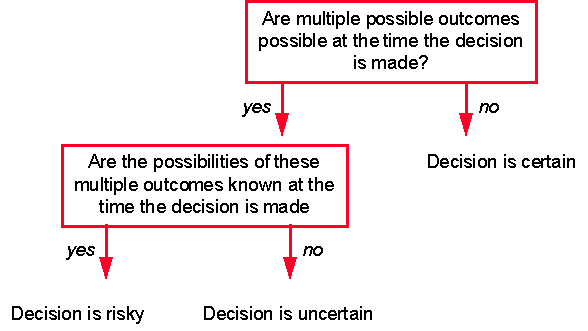Certain, Risky, And Uncertain Decisions.
The following figure illustrates how to distinguish among certain, risky, and uncertain decisions.

C - DECISION MAKING IN ORGANISATIONS
INTRODUCTION.
Managers within organizations make decisions and permeates everything an organization does.
Decisions are the means by which organizations turn ideas into action and can have a positive or a negative impact.
The conditions under which decisions are made in organizations is shown on the following diagram

Types Of Decisions Made In Organisations.
A choice made from among a set of alternatives is a decision. Decision making is the process of identifying alternatives, evaluating alternatives, and selecting an alternative.
Organizational decisions can be described in terms of two dimensions:
Programmed And Nonprogrammed Decisions.
The degree to which decisions are programmed depends upon the number of times similar decisions have been made in the past.
Certain, Risky, And Uncertain Decisions.
The following figure illustrates how to distinguish among certain, risky, and uncertain decisions.

These decisions are among the hardest to make because managers do not know what the outcomes might be. Managers make them because they believe the chosen course of action is the right thing to do. Managers try to make uncertain decisions succeed by marshalling the organization's resources.
RESPONSIBILITY FOR DECISION MAKING.
Different types of decisions are made at different levels in the organizational hierarchy.
Generally top managers make both nonprogrammed decisions and risky and uncertain decisions.
Middle managers often have the task of transforming nonprogrammed decisions into programmed ones and transforming risky decisions into certain ones.
Lower-level managers generally make programmed and certain decisions.
THE DECISION-MAKING PROCESS.
The steps in the decision-making process are identifying alternatives, evaluating alternatives, and selecting from among alternatives. The classical model of decision making provides the logic for much decision making. Behavioral aspects of decision making create deviations from this approach.
The Rational Decision-Making Model.
Rational decision making keeps the decision maker focused on facts and logic and helps guard against inappropriate assumptions and pitfalls. The approach is aimed at;
The output from this process is to produce a decision that best serves the interests of the organization
The six steps in the classical decision making model are;
1. Recognizing the need for a decision: Decision making is necessary when there is a gap between the actual state of the organization and the desired state.
2. Diagnosing the problem: Diagnosis allows managers to understand why a gap between actual and desired states exists. In diagnosing the problem, managers usually collect data and information about each plausible explanation for the gap.
3. Developing alternatives: Only after identifying the cause of a problem can an organization begin to develop alternative solutions. According to classical decision-making theory, all possible alternative solutions should be explored.
4. Selecting alternatives: Managers must decide which alternatives to implement. Optimal solutions are alternatives that address a particular problem in the most complete way possible but at lowest cost.
5. Implementing alternatives: Implementation occurs when the ideas and principles represented in a decision are actually put into operation by organizational members.
6. Exercising control and follow-up: Classical decision making is completed only when organizations exercise control and follow-up.
BEHAVIOURAL ASPECTS OF DECISION MAKING.
The classical decision-making model is very logical, very linear, in its approach. Limits on the information-processing capacities of decision makers sometimes make it impossible to use the classical model. Moreover, decision making in organizations is often influences by a variety of social and psychological phenomena.
The administrative model describes how decisions often actually are made based on the assumptions that managers have incomplete and imperfect information, are constrained by bounded rationality, and tend to satisfice when making decisions.
1. Bounded rationality describes the limited capacity of decision makers to process information. Most organizational decisions are made under conditions of bounded rationality. In general, the more complex a decision is or the longer the time frame of knowing the consequences, the more decision makers are limited by bounded rationality.
2. Optimizing is searching for optimal solutions. Satisficing is searching for satisfactory solutions. Typically organizations search not for optimal solutions but for satisfactory solutions. Costs and time factors are considered as organizations decide whether to satisfice or optimize.
3. Three powerful social and psychological factors limit the application of classical decision making in organizations.
GROUP DECISION MAKING.
Any decision-making process that is performed by several individuals is group decision making.
Advantages Of Group Decision Making.
The amount of information and experience available can be increased by including more individuals in the decision-making process. Group decision making tends to generate more alternatives, possibly allowing the organization to optimize more. Communication and understanding are also increased when group decision making is used. This, in turn, increases the likelihood of the decision's being accepted and supported.
Disadvantages Of Group Decision Making.
The amount of time needed for making a group decision is a big drawback. Group decision making can also force compromises when strong, decisive actions might be needed. Finally, group decision making can encourage groupthink, which is a phenomenon that emerges in a group when the group members' desire for consensus and cohesion outweighs their desire to make the best possible decision.
TECHNIQUES FOR GROUP DECISION MAKING.
Several specific group decision-making techniques can be employed by organizations.